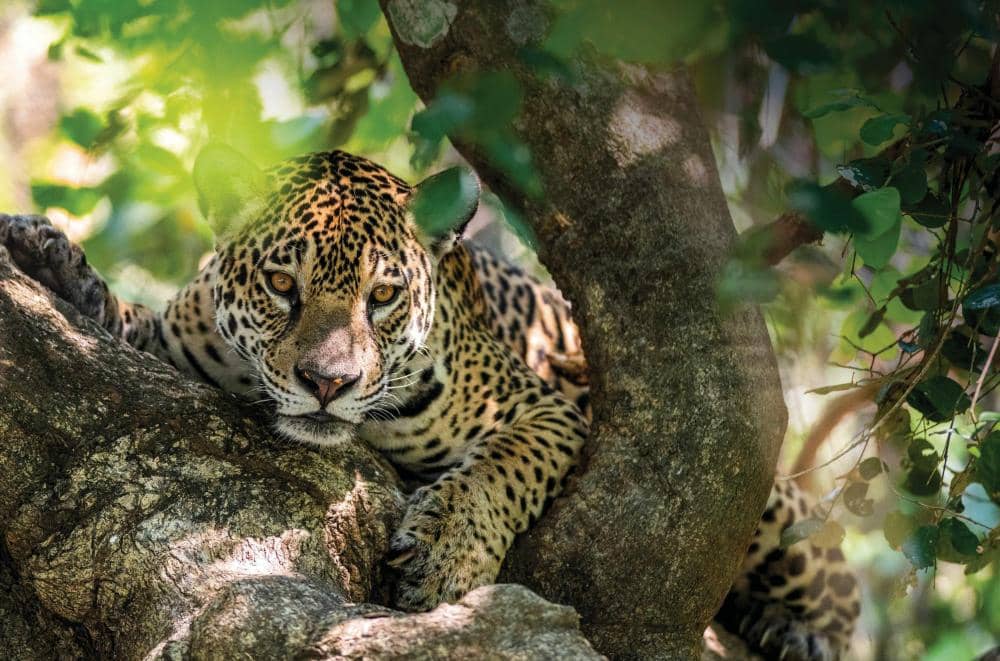
A DOZEN RIVERBOATS HUDDLE AGAINST the bank of a narrow tributary of the Rio Cuiabá in Brazil. The passengers on board jostle soundlessly to get the best view, while their camera lenses reach out like limbs across the water towards a patch of sand on the opposite bank
The mother emerges from the shrub first. She struts out onto the beach with an air of nonchalance. Her two cubs tumble out after her, splashing and play-fighting in the water to the delight of the tourists, who are all hungrily snapping photographs. It's our second jaguar sighting of the day. Given what happened here not too long ago, I can scarcely believe our luck. “Luck?” our guide Fisher Sousa says, raising an eyebrow. “We see jaguars every day.”
In 2020, the Pantanal, the planet's largest tropical wetland - an area larger than England, spanning Brazil, Paraguay and Bolivia - and the home of the highest concentration of jaguars on Earth, was engulfed in flames. Thirty per cent of the biome was scorched beyond recognition. International news reports showed apocalyptic images of wildfires surging through the forest, leaving the charred remains of coati and tapir in their wake. For people like Sousa, working in the Pantanal's developing ecotourism industry, there was a concern about what the fires would mean for the region's flagship species: the jaguar.
The Jaguar ID Project has built up a catalogue of 284 jaguars in the Pantanal's Porto Jofre river system, each one identified by its unique spot pattern. According to Abbie Martin, the project's director, the data on jaguars after the fires paints a promising picture. “After 2020, people seized on this narrative that the jaguars were dying,” she says. “But look at the numbers from 2019 and 2020, and compare them to 2021.”
この記事は BBC Wildlife の Spring 2022 版に掲載されています。
7 日間の Magzter GOLD 無料トライアルを開始して、何千もの厳選されたプレミアム ストーリー、9,000 以上の雑誌や新聞にアクセスしてください。
すでに購読者です ? サインイン
この記事は BBC Wildlife の Spring 2022 版に掲載されています。
7 日間の Magzter GOLD 無料トライアルを開始して、何千もの厳選されたプレミアム ストーリー、9,000 以上の雑誌や新聞にアクセスしてください。
すでに購読者です? サインイン

SNAP-CHAT
Justin Gilligan on giant spider crabs and holding hands with an octopus

STEPPE CHANGE
Herds of saiga have returned to Kazakhstan, but there's a fine balance to tread

TREES FOR LIFE
Community is at the heart of conservation in the tropical forests of southern Belize

WHEN DOVES CRY
Turtle doves are now the UK's fastest declining bird species, but the RSPB is on a mission to save them

SURVIVAL OF THE CUTEST
We can't help being drawn to cute creatures, but our aesthetic preferences both help and hinder conservation

LIGHT ON THE NORTH
Spectacular images of Arctic foxes, reindeer and musk oxen reveal the wild beauty and diversity of Scandinavia

ROLLING IN THE DEEP
The super-sized crustacean that lives in the deepest, darkest ocean

LET'S GET TOGETHER
Clay licks deep in the Amazon explode in a riot of colour, with macaws the stars of the show

FEMALE OF THE SPECIES
To sponge or not to sponge? That is the question for the bottlenose dolphins (Tursiops aduncus) living in Shark Bay, Western Australia.

7 nature encounters for the month ahead
WITH NATURALIST AND AUTHOR BEN HOARE